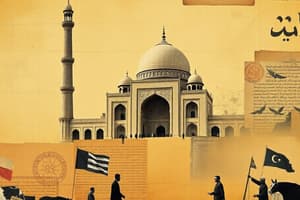Podcast
Questions and Answers
What is the definition of history according to the given content?
What is the definition of history according to the given content?
- A collection of important dates and events.
- An academic discipline focused solely on political events.
- A narrative about past events that carries meaning for a group of people. (correct)
- A chronological list of wars and battles.
Which concept is described as the 'art and science of interpretation'?
Which concept is described as the 'art and science of interpretation'?
- Semiotics
- Hermeneutics (correct)
- Narratology
- Anthropology
What distinguishes interdisciplinary studies from multidisciplinary studies?
What distinguishes interdisciplinary studies from multidisciplinary studies?
- Multidisciplinary studies ignore the relationships between sciences.
- Interdisciplinary studies view sciences as isolated.
- Multidisciplinary studies rely on a single focal science.
- Interdisciplinary studies emphasize the interconnectedness of sciences. (correct)
What does the term 'semiotics' refer to?
What does the term 'semiotics' refer to?
Which is NOT considered a basic hermeneutical process?
Which is NOT considered a basic hermeneutical process?
Which of the following best describes the 'World of the Text'?
Which of the following best describes the 'World of the Text'?
What role does history play in the 'World Behind the Text'?
What role does history play in the 'World Behind the Text'?
Which of the following is NOT a type of analysis mentioned in the content?
Which of the following is NOT a type of analysis mentioned in the content?
What term describes the typology that blends the world of the text with the world behind the text to extract contextual meaning?
What term describes the typology that blends the world of the text with the world behind the text to extract contextual meaning?
Which of the following is NOT a type of contextual reading mentioned?
Which of the following is NOT a type of contextual reading mentioned?
Which artist is associated with the works 'Spoliarium' and 'Las Damas Romanas'?
Which artist is associated with the works 'Spoliarium' and 'Las Damas Romanas'?
What is the primary focus of historical criticism?
What is the primary focus of historical criticism?
Which of the following describes the role of internal criticisms?
Which of the following describes the role of internal criticisms?
What type of criticism looks at an artwork's relationship with contemporary social issues?
What type of criticism looks at an artwork's relationship with contemporary social issues?
What aspect does 'intertextual analysis' focus on when examining 'Spoliarium'?
What aspect does 'intertextual analysis' focus on when examining 'Spoliarium'?
Which concept refers to the push of various ideologies and beliefs influencing art?
Which concept refers to the push of various ideologies and beliefs influencing art?
Study Notes
History and its Meaning
- History is the narrative of past events that holds significance for specific groups of people in a certain place and time.
- History is a combination of written, visual, and oral narratives, often overlapping.
- The word "Kasaysayan" in Filipino is derived from the words "salaysay" (narrative) and "saysay" (meaning), highlighting the importance of both the story and its meaning.
History as an Integrated Science
- History is viewed as an interdisciplinary science, meaning it involves the interconnected study of various disciplines, with a central focus on historical events.
- History draws connections and insights from Anthropology, Sociology, Philosophy, and Theology.
- Multi-disciplinary study in history involves multiple interconnected sciences examining a topic in equal terms.
Semiotics: The Science of Signs and Symbols
- Semiotics is the study of signs and symbols, including verbal, non-verbal, and sexual communication.
- We are surrounded by signs and symbols, which play a crucial role in understanding the world around us.
Hermeneutics: The Art and Science of Interpretation
- Hermeneutics is the process of interpreting and understanding meaning in texts, objects, and ideas.
- It involves deconstruction and reconstruction, analyzing the structure, meaning, and context of the object of analysis.
Basic Processes in Communication
- The sender transmits a message to the receiver, leading to communication.
Basic Hermeneutical Processes
- The world of the text encompasses the subject, form, and theme, undergoing analysis through various methods like structural analysis, textual criticism, and synchronic analysis.
- The world behind the text considers the history, context, and people behind the story, using diachronic analysis, historical criticism, and contextual reading.
The Context of Juan Luna and his Spoliarium
- Juan Luna's Spoliarium is an example of a text that can be analyzed using hermeneutical methods.
- The artist's biography, background, cultural context, beliefs, and perspectives, particularly the power struggle, intentions, and historical background, are all crucial elements for understanding Spoliarium.
Intertextual Criticisms
- Examining Juan Luna's Spoliarium alongside his other works reveals a deeper understanding of his artistic style and themes. Important examples are: "Las Damas Romanas," "La Muerte de Cleopatra," and "Parisian Life."
- Comparing Juan Luna's work with his contemporaries, such as Felix Resurrection Hidalgo's "Las virgenes Cristianas expuestas al populacho" and "La Madre en el Claustro," provides a broader context for interpreting his art.
Exegesis: Blending Textual and Contextual Meaning
- Exegesis is the process of integrating the world of the text and the world behind the text to draw out the contextual meaning. It examines the dialogue between the text and its context.
Eisegesis: Applying Contextual Meaning to Contemporary Readers
- Eisegesis involves applying the contextual meaning gained through exegesis to current readers, considering its relevance to present-day personal, social, or global issues.
- It analyzes the dialogue between the contextual meaning and contemporary realities, addressing issues that resonate with the audience today.
Studying That Suits You
Use AI to generate personalized quizzes and flashcards to suit your learning preferences.
Related Documents
Description
This quiz explores the meaning of history as both a narrative and a multidisciplinary science. It also delves into semiotics, the study of signs and symbols, and how they relate to communication and historical context. Engage with concepts that bridge various disciplines through the lens of historical significance.




